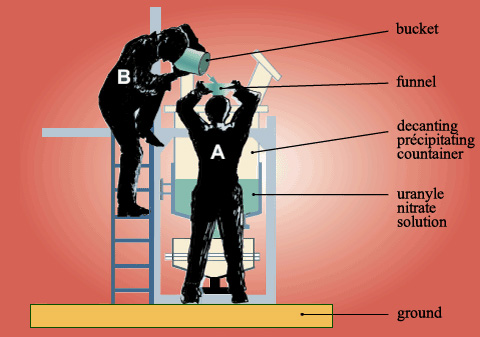1999 : a « criticity » accident in Japan
This surprising accident of « criticality » came about in October 1999 in Japan. It did not happen at a nuclear power plant, but in a high tech facility, specialised in enriched fuel, situated in Tokai-Mura, 150 km North-East of Tokyo.
came about in October 1999 in Japan. It did not happen at a nuclear power plant, but in a high tech facility, specialised in enriched fuel, situated in Tokai-Mura, 150 km North-East of Tokyo.
One of the Tokai-Mura unit was dedicated to the production of nuclear fuels for research reactors with an isotope 235 enrichment that coud reach 20%, the yearly being at most 3 tons. The operations consisted in pouring uranium powder (enriched at 18.5% of uranium-235 and previously dissolved in nitric acid) in a container also containing nitric acid. This container normally had an adapted geometry preventing the development of a chain reaction.
To not waste time and finish the work faster, the technicians responsible for the preparation poured in one entire go the enriched uranium in the container. They inserted 16.6kg of enriched uranium, seven times more than the recommended 2.4 kg guaranteeing the absence of any risk of criticality. In doing this, they exceeded the critical mass, triggering an explosion of gamma and neutrons
and neutrons .
.

Circumstances of the Tokaimura accident
This diagram shows the circumstances of the criticality accident in Tokai-mura. The buckets, unloaded by two Japanese technicians contained uranium highly enriched in fissile U-235 isotope. By exceeding more than seven times the amount permitted by safety standards, they caused an early chain reaction that cost their lives. The large container in which they poured the uranyl nitrate to save time had a unconvenient shape. If he had been flat, for example, the accident could have been avoided.
© Clés CEA
In addition, the adapted geometrical equipment had been replaced by a tank of large dimensions, through ignorance or lack of training: The accident would have been avoided if a container in the shape of a flat plate had been used. The investigation showed that the staff from the factory did not respect the safety requirements that were in fact not even indicated.
The exceeding of the critical mass set off the beginning of an atomic explosion. The development of this explosion luckily stopped very quickly. The contamination stayed insignificant and limited to the factory. The authorities evacuated 160 people living in the town to a radius of 350 metres, and 300 000 people received a warning to remain in their houses until the end of the accident.
The accident caused the death of two technicians who made the mixture. One of them, Hishashi Obuchi, had been exposed to a dose 17000 times the standard maximum, set by Japan for one year, and 4 to 5 times the lethal dose. A third technician who was in a neighbouring room, was less exposed and survived .
Criticality accidents, known since the discovery of nuclear power, are very rare nowadays. Most of them occurred in the 1950s and 60s and did not lead to significant radioactive pollution in the environment. Since 1945, sixty criticality accidents have been reported worldwide, mainly in the United States (33) and in the former USSR (19). They have killed 19 people including 15 between 1953 and 1971. Two thirds of these accidents occurred in research reactors.

A rare accident type
Criticity accidents are rare. In total 22 such accidents occured in nuclear fuel production facilities, having killed 9 victims, Tokaimura accident beeing the last otherwise. Moreover,38 other criticity accidents, resulting in 12 deaths, occured in experimental research reactor facilities since their beginning at Los Alamos in 1945 until the last in 1997.
© CEA
The Japanese government revoked the exploitation licence given to the “Japan Nuclear Fuels Conversion Company”. The accident of Tokai-Mura coincided with a scandal involving the falsification of data concerning plutonium pellets provided by a British company (Sellafield reprocessing plant). This damaged the image of the nuclear industry of which Japan was counting on reducing its CO2 emissions and the effects of greenhouse gases at the level of 1990.
Other articles on the subject « Nuclear Accidents »
The INES scale
The severity scale of nuclear accidents Nuclear installations and their operation are complex and[...]
Accidents of radioactivity
The importance of a close monitoring of radioactive sources… In many countries, the possess[...]
Accident Causes
Human errors, design flaws and natural cataclysms A nuclear accident dwarfs all other types of ac[...]
Mayak Accident
A military long-hidden nuclear accident of the Soviet era Long before Chernobyl, it was suspected[...]
Windscale Accident
Windscale : an accident of the U.K nuclear weapon program (1957) The fire which occurred the 10th[...]
Three Mile Island
1979: A major accident that led to the destruction of a reactor The Three Mile Island plant (TMI)[...]